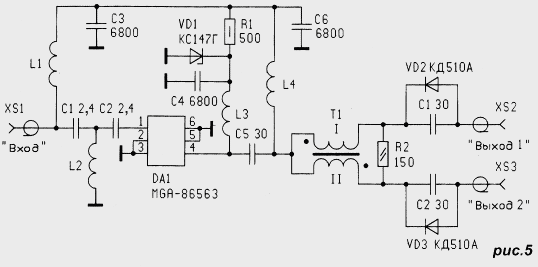I have had one LNA die on me for no obvious reason, but i have also noticed a tingling feeling when i touch the metal parts on the old usb sdr v3 dongle. Now the 5v power supply is a no name, generic plug pack. Could it be high voltage leakage across the high frequency transformer + 200Lb gorilla pocking around a live circuit, barefoot outside that killed the LNA?
Should we be using only grounded/earthed SMPS?
LNA’s are pretty sensitive to ESD (electrostatic discharge). When the humidity is low (30 % or lower), you can zap some of these parts easily.
There’s no shortage of articles on ESD protection for LNAs. Here’s an Application Note:
https://www.infineon.com/dgdl/AN178_RF_Antenna_Protection.pdf?fileId=db3a30431ddc9372011e49927ebb70c1
Hi Konrad, Thanks for the information. That answers that question.
Of course earthing the LNA will not improve the situation, it could only make it worse.
(by providing a path to ground for the electrostatic “zap”)
My Outernet LNA is still working fine, but I destroyed a similar LNA for S-band just by connecting a helix
antenna to it and then touching the helix without grabbing the backplate first.
Your attaching an antenna without proper ESD protection is actually a testament as to how static sensitive LNAs really are.
The MAX12000 used in a the NooElec LNA and SAW filter has ESD protection up to 1KV. Many LNAs have no protection at all. However, it’s not hard to 1KV or more of a charge built up during dry weather.
MAX12000 Data Sheet
And, to the contrary, providing a high voltage path through to ground that bypasses the LNA does help prevent ESD damage. It’s best practice in commercial applications to use gas discharge tubes, MOVs, or back to back diodes on the input to the LNA. There are solutions that involve inductors as well. ESD protection and proper grounding keeps your LNA from being the fuse for your SAW filter and SDR.
–WA4OSH, Konrad
Of course it is good to have ESD protection and grounding, but in the absence of ESD protection, grounding will do nothing or will make it worse. After all, the discharge through the component will only find a lower impedance to ground in that case.
My S-band LNA was an MGA86563. It had the input via a small capacitor but no other protection.
An inductor to ground would likely have saved it. I added it, but have not yet replaced the MGA86563.
The datasheet mentions nothing about ESD, which likely explains why the developer of the LNA (actually it is part of a converter to 70cm) did not think of protecting it…
I hate to hand someone the “I told you so” ;). I see ESD sensitive parts all the time at work. They do require ESD protection that are not often on the cheapie LNAs you buy on Amazon, E-Bay, or demonstration boards.
Snipped right from the MGS86563 data sheet:
GaAs FETs are notoriously static sensitive.
[MGA-86563 Datasheet](file:///C:/Users/Konrad/Downloads/AV02-2514EN-DS-MGA-86563-27Oct20100.pdf)
–Konrad, WA4OSH
On the NooElec LNA, you can see D1 on the left … that’s there to discharge ESD on the input. C1 is there to prevent the LNA from getting destroyed is someone plugs the in the wrong side with a coax that has DC on it (from the bias tee).
Cheapie LNAs won’t have anything more than the LNA chip, a couple of caps and maybe a power supply regulator. Most of them don’t even come with the bias tee on board.
Adam, 9A4QV’s article might shed some light on what a bias tee does…
BIAS Tee discussed on LNA4ALL page
–Konrad, WA4OSH
Hi…i am a new user here. In my case it had the input via a small capacitor but no other protection.
An inductor to ground would likely have saved it. I added it, but have not yet replaced the MGA86563.
The datasheet mentions nothing about ESD, which likely explains why the developer of the LNA.
Inductor to ground?
EG like L2 in this schematic? (I just stole this Russian schematic off the Internet somewhere)

That’s a high-pass filter. It keeps FM and TV stations, etc (anything below about 800 MHz) from overloading the input of the LNA.
That’s still not input protection for over-voltage, etc.
–Konrad, WA4OSH
